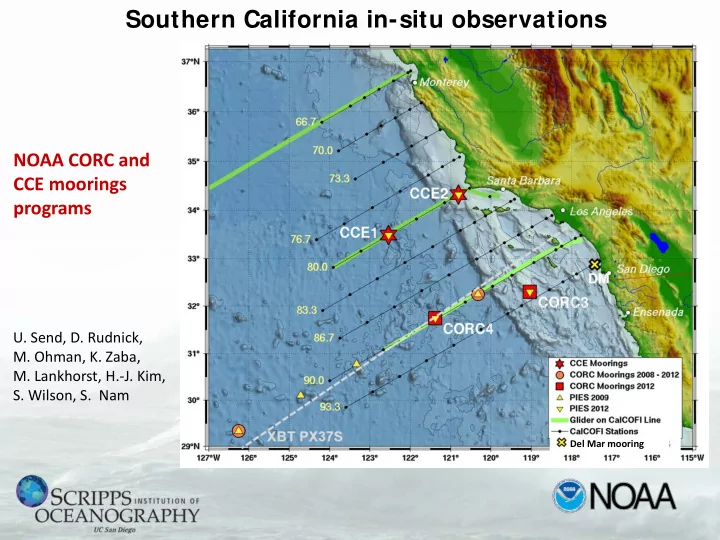

Southern California in-situ observations NOAA CORC and upwelling CCE moorings (CCE2) programs Core-CC current shelf (CCE1) (Del Mar) U. Send, D. Rudnick, M. Ohman, K. Zaba, M. Lankhorst, H.-J. Kim, S. Wilson, S. Nam Del Mar mooring
Large-scale view from gliders (see also Zaba&Rudnick poster) Anomalous warming starts beginning of 2014, over large region.
Shallow/ surface-intensified in average over large area off So Cal Line 66.7 Line 80 Line 90
Warming trend in anomaly may already have started in prior years
NCEP NAM model: high surface heat flux/ low wind stress since 2013 Suggests warming by anomalous surface heat flux and reduced upwelling
15m anomalies at CCE2 mooring Localized views from moorings: SFU NO 3 O 2 0-30m T anomalies at Del Mar mooring
The warm anomaly developed already during a cooling phase: Higher surface heat fluxes ? - Reduced upwelling ? - Advection from offshore (downwelling) ? - I ncreased advection from south ? - the cooling requires upwelling CCE2 layer-average T 0-30m 10-50m 30-60m CCE2 0-30m average T anomaly
Moorings can measure the upwelling circulation CCE2 progressive vector diagram 2013 - alongshore/cross-shore well defined - upper layer offshore for 6 months, then relaxation-like poleward flow - deeper layers always poleward North-south displacement [km] East-west displacement [km] - Upper layer nearly always offshore flow negligible downwelling, also not in 2014 - Break in slope mid-year - 2014 had ongoing offshore flow - Similar at Del Mar mooring
Cross-shelf shear is highly correlated with wind (2deg to the south) CCE2 velocities in offshore direction 2014 average of upwelling circulation was not anomalously low CCE2 shear correlation with wind stress Negative alongshelf windstress 2⁰ to south upwelling shear
less upwelling NCEP NARR model along-shelf wind stress anomaly 1deg away from the coast more upwelling more upwelling less upwelling Upwelling winds in NARR model not anomalously low (except north of Pt. Conception from summer 2014). (confirmed by NDBC buoy south of Pt. Conception)
I ntegrated upper-layer poleward flow (displacement) CCE2 progressive vector diagram 2013 North-south displacement [km] CCE2 cumulative poleward flow (18m depth) Poleward displacement [km] East-west displacement [km] Poleward after end of upwelling season (seasonal relaxation). Large anomalous upper- layer poleward flow in 2013, 2014, 2015
North-South water mass index shows more southern water in 2012/ 2013 Del Mar CCE2 CCE1
SST suggestive of northward flow before warming Northward Jan’13 advection WILL bring warmer water. Note N/S and E/W gradients which are lost in anomaly maps. Jan’14 CORC state estimate also shows long enough poleward flow off Baja California to reach Pt. Conception (B.Cornuelle/G. Gopalakrishnan)
Recap and pressing questions: - Upwelling continues during anomalous warming phase (i.e. not warming by onshore flow) - Upwelling (overturning) circulation (and winds) apparently not weaker in 2014 - Anomalous alongshore advection brings anomalous warm water into region (near the coast), already in preceding years - Different starting conditions for upwelling season - Surface heat fluxes probably larger in 2014, but different models give different answers: Model net surface heat fluxes NCEP NAM model Colors: NCEP NARR model If surface heat flux forcing is atmospheric, how did poleward flow propagate/get generated ?
Recommend
More recommend